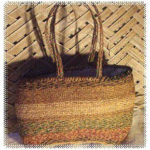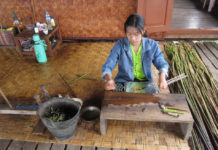Mosikaka is a Tongan name given to a very special old type of weaving. The local material used for mosikaka weaving was the coconut fibres.
The niu kafa is a type of coconut tree that bears large fruits. The fruit’s husk is very thick, but the nut inside is very small. The fibres of the niu kafa are longer and make the weaving easier.
Preparation of the coconut fibres for weaving is very important. The husks of the matured nuts are separated from the nut inside and are soaked in water for two days or more. Then they are taken out one by one and beat with a beater on a log of wood to clean out all bits that stick to the fibres. Once cleaned, then they are put out in the sun to dry.
The original weave is done with single fibres. The actual weaving is done in pairs of three lots working their way parallel to each other in two rows at the same time. It involves remembering the process using the warp (fe’unu fokotu’u) and weft (fe’unu fakalava) to make the weave in the correct order. Holding the fibres in your fingers contributes to the weaving itself. Fingers have to be trained to hold and pull the fibres lightly to make the weave lie smoothly and connected.
Tonga is the only country in the world that does the mosikaka weaving. To prove this claim, the word “mosikaka” appears only in the Tongan dictionary. Previously, the mosikaka baskets were woven in black and brown coconut fibres. The weavers used small hollow shells to decorate their baskets. At present, the fibres can be dyed in different colours for mosikaka weaving. Fibres can also be doubled and twisted to make it thicker for weaving or plaited into thin sinnet.
Tongans respect very highly chiefs and royalties. Mosikaka baskets are considered to be fine works of art and very befitting to be presented to those of high rank in our society. We value that cultural link of the mosikaka basket to the royal household.
Lesieli K. Tohi-Tupou wove this mosikaka handbag for a display during the coronation of King Tupou VI, July 2015. It is now owned by Crown Princess Sinaitakala Tuku’aho.
Mosikaka weaving in Tonga has been revived through training of women in the community. The training methodology using pandanus helps women understand the process and be able to produce various marketable items to generate income to their families. By the time they are experienced and familiar with the mosikaka weaving techniques, they can make, create and innovate to design more products for cultural exhibition and festivals. And more importantly they will be able to make the real mosikaka baskets with coconut fibres.
At present, there is one mosikaka basket at the Tupou College museum, Tongatapu. Some members of the royal family have some mosikaka items in their possession.
Lesieli K. Tohi-Tupou (the author) has taught groups of women including one male in Tongatapu and in the outer islands on mosikaka weaving. The male weaver is the only one implementing the mosikaka weaving in a more innovative approach and he’s very successful. Lesieli K. Tohi-Tupou is the only weaver in Tonga that practices mosikaka weaving in its original form.
Future reading
Lesieli K. Tohi-Tupou E Lalanga Mosikaka Mo Hono Fakalakalaka (Innovation on Traditional Mosikaka Weaving) USP Press , April 2014.









